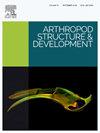Fine structure and adaptive variation of compound eyes in two species of infralittoral prawns (Palaemon, Caridea): New insights into imaging mechanisms of reflecting superposition eyes in decapod crustaceans
IF 1.3
3区 农林科学
Q2 ENTOMOLOGY
引用次数: 0
Abstract
The main goal of this study has been to explore and compare the functional morphology and photoadaptive patterns of the compound eyes of two closely related prawn species both inhabiting different infralittoral visual environments. Using light and transmission electron microscopy we investigated light- and dark-adapted ommatidia of the light-resistant Palaemon elegans and the shade-preferring Palaemon xiphias. Ommatidia of both Palaemon species generally share the same cellular architecture, except for the irregular 8th retinula cell building up the distal rhabdom. This structure functions as UV-light receptor and potential light guide, providing dichroic vision and protection of the subjacent main (banded) rhabdom, formed by the remaining retinula cells 1–7, from harmful UV-radiation. As both the apical 4-lobe system of the 8th cell and the distal rhabdom are much stronger developed in P. elegans, we conclude that different light intensities in the respective photohabitats have led to noticeable micro-evolutionary adaptations at cellular level. In contrast, the main (banded) rhabdom, is capable of perceiving polarized light which is of special photo-ecological benefit for the diurnal P. elegans when populating shallow rock pools.
The ommatidial ultrastructure of both species is very similar in the dark-adapted state. Many traits support reflecting superposition: such as (1) square corneal facet and crystalline cone, (2) the clear zone along main rhabdoms, (3) a mirror layer established by interommatidial pigment cells, and (4) the proximal tapetum established by reflecting pigment cells below the rhabdom. During light-adaptation, a massive turnover and shift of both organelles or whole cell bodies along the ommatidial optical axis enables the use of functional apposition optics at daytime in both study species. Some major differences in light-adaptation patterns and the assumed efficiency of functional apposition can be explained by adaptations to different light habitats.
Our TEM study shows that shifting patterns of various pigment granules in interommatidial pigment cells, which occur over light adaptation, are species-specific. As a first measure to protect the main rhabdom from excessive light we identified the super-fast breakdown of a mirror layer around the cone's tip which is made of crystal granules and, thus, widens the aperture of ommatidia in superposition mode at night.
两种颌下对虾复眼的精细结构和适应性变化:十足甲壳类动物反射叠加眼成像机制的新见解
本研究的主要目的是探讨和比较生活在不同海下视觉环境的两种近亲对虾复眼的功能形态和光适应模式。利用光镜和透射电子显微镜研究了耐光秀丽古鳗和喜阴剑鳗的光适应和暗适应小眼。除了不规则的第8视网膜细胞形成远端横纹肌外,两种古蜥蜴的小眼通常具有相同的细胞结构。这种结构的功能是紫外线受体和潜在的光导,提供二色视觉和保护下主(带状)横纹肌,由剩余的视网膜细胞1-7组成,免受有害的紫外线辐射。由于线虫的第8细胞的顶端4叶系统和远端横纹肌的发育都要强得多,我们得出结论,在各自的光栖息地中,不同的光强度导致了细胞水平上明显的微进化适应。相比之下,主要(带状)横纹肌能够感知偏振光,这对于昼夜活动的秀丽隐杆线虫在浅岩池中生存时具有特殊的光生态效益。在黑暗适应状态下,两种植物的基质超微结构非常相似。许多特征支持反射叠加:如(1)正方形的角膜小面和晶状体,(2)沿主要横纹肌的透明区,(3)由间质色素细胞建立的镜像层,(4)横纹肌下方通过反射色素细胞建立的近端绒毡层。在光适应过程中,细胞器或整个细胞体沿母光轴的大量周转和移动使两个研究物种能够在白天使用功能对位光学。光适应模式的一些主要差异和功能匹配的假设效率可以通过对不同光生境的适应来解释。我们的透射电镜研究表明,在光适应过程中,间质色素细胞中各种色素颗粒的转移模式是物种特异性的。作为保护主要横纹线免受过度光照的第一个措施,我们确定了锥体尖端周围的镜面层的超快速分解,该层由晶体颗粒组成,因此在夜间以叠加模式扩大了横纹线的孔径。
本文章由计算机程序翻译,如有差异,请以英文原文为准。
求助全文
约1分钟内获得全文
求助全文
来源期刊
CiteScore
3.50
自引率
10.00%
发文量
54
审稿时长
60 days
期刊介绍:
Arthropod Structure & Development is a Journal of Arthropod Structural Biology, Development, and Functional Morphology; it considers manuscripts that deal with micro- and neuroanatomy, development, biomechanics, organogenesis in particular under comparative and evolutionary aspects but not merely taxonomic papers. The aim of the journal is to publish papers in the areas of functional and comparative anatomy and development, with an emphasis on the role of cellular organization in organ function. The journal will also publish papers on organogenisis, embryonic and postembryonic development, and organ or tissue regeneration and repair. Manuscripts dealing with comparative and evolutionary aspects of microanatomy and development are encouraged.

 求助内容:
求助内容: 应助结果提醒方式:
应助结果提醒方式:


